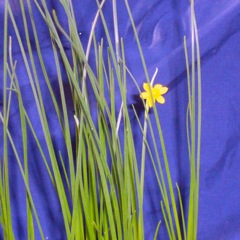I don’t mean to give you the mistaken impression that all Miniature crosses yield spectacular flowers. Obtaining seedlings that are “better” than both parents in multiple aspects has been the exception rather than the rule for me. Panning for gold seems to be analogous to hybridizing for Miniatures. In gold panning, you expect to have to sift through literally tons of muck, silt, sand, and gravel to obtain a few flecks of gold. I find the same is true in Miniature hybridizing.
The attached photo is of a “record” breaking cross. Unfortunately, the record broken isn’t a good record. The photo is of a clone of a 2000 cross of N. wilkommii x N. fernandesii. The photo was taken today of the first and only maiden bloom from 31 total seedlings. The 30 siblings have double fist sized foliage clumps outside in the field with nary a bloom scape in sight. This is after eleven years with no flowers, hence the record. Out of irritation/desperation I chose a clump at random last summer and dug it. After dividing the clone into large pieces, I lined nine bulbs outside in a row (again) and potted eight inside for the greenhouse bench. Seventeen bulbs after eleven years might also be a record. One of the bulbs from the pots in the greenhouse apparently decided that the celestial forces were in alignment somehow, and it was now time to bloom.
As you can see, the flower is a combination of the “poorest” attributes from both parents. We know so little about the range of expression possible with many, many, of both the inter and intra sectional species hybrid crosses. Many crosses of this type a purely speculative and made to try and simply get a sense of what might be possible. Perhaps I don’t have the right stocks of N. wilkommii and there may surely be some that are not as shy flowering. For me, with the stocks of bulbs I have obtained along with those that I have raised from seed, I find that N. wilkommii (and N. gaditanus!) are shy flowering at best.
The expression “if god gives you lemons, make lemonade” has been applied in this case. A potential name and catalog description are written below. Please remember that I am trying to emphasize the best features of this plant.
Never Bloom 7Y-Y (believed to be a 7Y-Y when it blooms); V00-122-14 = N. wilkommii x N. fernandesii; S. J. Vinisky, USA, 2011, Bloom Season: none
Offered strictly as a dwarf foliage plant. Perfectly vertical, rush leaved foliage reaches six to seven inches tall. The foliage makes for an ideal companion or counterpoint to other low spreading plants like viola, pansy, phlox, etc., that actually bloom. Ultra low maintenance plant as one rarely, if ever, has to deadhead those pesky blooms. Note: very sporadically this foliage plant may actually produce a scruffy, tiny flower that is held well down in the foliage so is often totally hidden. These should be removed promptly to preserve the wonderful foliage effect. Strong grower and rapid increaser that always produces scads of clumps of dwarf, fountain like foliage. No matter how well (or poorly!) you grow this, the plant simply gives you more and more foliage. An exciting new introduction for those that really like leaves.
Sent with Smiles and Good Cheer to you all on a cold, snowy Saturday morning here in Oregon,


Steve:
Your observations just made my day. I think you should off er a bulb of ‘Never Bloom’ to the ADS auction. those who love leaves will clamor for it
Harold
Steve,
You also pointed out a major requirement for daffodil breeders–a sense of humor! Thanks for a fun start to the day.
Mary Lou
Actually, a foliage plant may just be of use in some gardens. Colleen